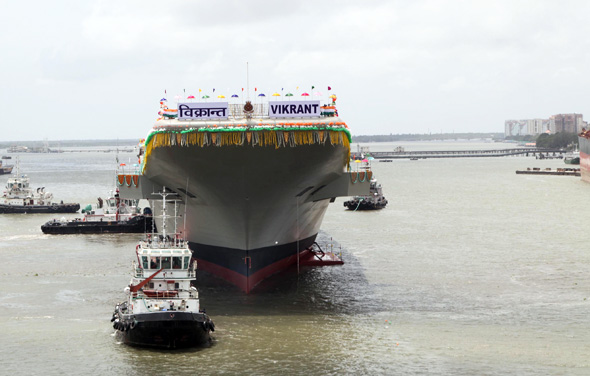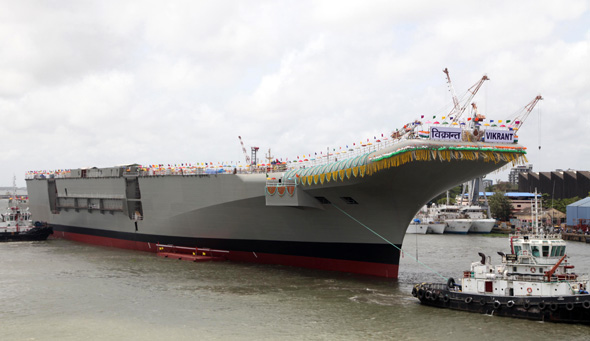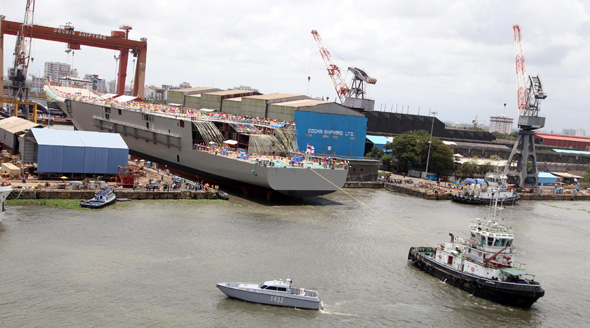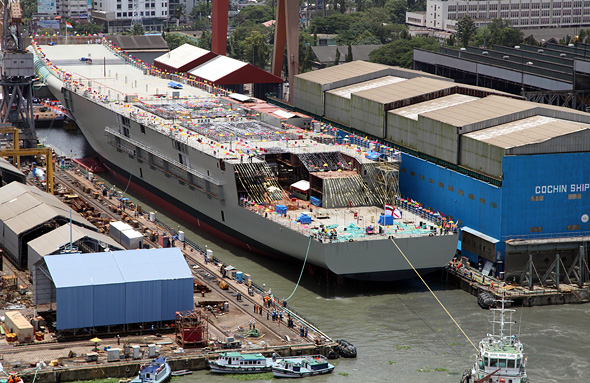INDIAN ARMED FORCES CHIEFS ON
OUR RELENTLESS AND FOCUSED PUBLISHING EFFORTS

SP Guide Publications puts forth a well compiled articulation of issues, pursuits and accomplishments of the Indian Army, over the years

I am confident that SP Guide Publications would continue to inform, inspire and influence.

My compliments to SP Guide Publications for informative and credible reportage on contemporary aerospace issues over the past six decades.
- Admiral Dinesh K. Tripathi assumes Command of the Indian Navy as 26th Chief of the Naval Staff
- Prime Minister witnesses 'Bharat Shakti' – a Tri-Services Firing and Manoeuvre Exercise in Pokhran, Rajasthan
- Interim Defence Budget 2024-25 — An Analysis
- Union Defence budget 2024
- Prime Minister Modi Commemorates Indian Navy Day in a Grand Ceremony
- Prime Minister Modi Flies in the LCA Tejas
- New Chapter in India-Italy Defence Ties
- Airpower beyond Boundaries
Indigenous aircraft carrier – A crowning glory
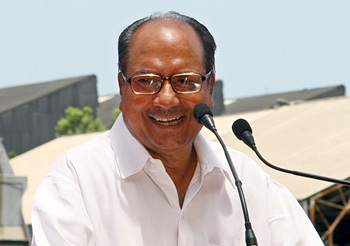
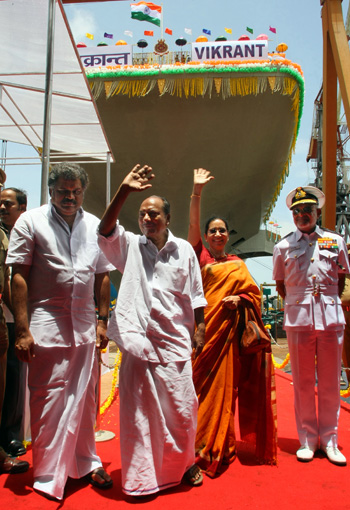
The traditional ceremony resplendent with graceful pomp and fervour was presided over by Antony, and witnessed by the Minister for Shipping, G.K. Vasan, Admiral D.K. Joshi, the Chief of the Naval Staff, Vice Admiral Shekhar Sinha, the Flag Officer Commanding-in-Chief, Western Naval Command, Vice Admiral Satish Soni, the Flag Officer Commanding-in-Chief, Southern Naval Command, Commodore (Retd) K. Subramaniam, Chairman and Managing Director, CSL and other officials from the Ministries of Defence and Shipping. Also present on the occasion were numerous naval officers, shipyard staff and workers and the officials from the Steel Authority of India Limited (SAIL), the manufacturers of the indigenous warship grade steel.
The formidable profile of hull structure, imposing ramp for short take-off but arrested recovery (STOBAR) of 37,500 tonnestrong Vikrant proudly demonstrated the rare indigenous design and shipbuilding capabilities that India has acquired on its own. The designed length of the ship is 260 m and breadth of 60 m. Over 80 per cent of the structure, containing about 2,300 compartments has been fabricated, over 75 per cent has been erected, all the major machinery, such as the two LM2500 gas turbines developing a total power of 80 MW, the diesel alternators capable of producing about 24 MW and the main gear box have been fitted.
Defence Minister described the occasion as momentous and said, “Today’s launching of the IAC marks just the first step in a long journey, but at the same time, an important one.” He said it was indeed a proud moment for the country to witness our efforts at achieving self-reliance in the field of warship design and construction, as only a very few advanced countries in the world possess the capability to design and build aircraft carriers.
Vikrant is the first ever aircraft carrier to be designed by the Directorate of Naval Design of the Indian Navy, the first warship to be built by CSL and the first warship to be built entirely using indigenously produced steel by SAIL. The construction of the ship is a truly pan Indian effort with active participation of private and public enterprises. The main switch board, steering gear and water tight hatches have been manufactured by Larsen and Toubro (L&T); the high capacity air conditioning and refrigeration systems have been manufactured by Kirloskars; most pumps have been supplied by Best and Crompton; Bharat Heavy Engineering Limited is supplying the integrated platform management system; gear box is supplied by Elecon in Gujarat; the tens of thousands of electrical cable is supplied by Nicco industries, Kolkata; the ship’s anchor chain cable is manufactured in Kolkata.
Vikrant will be capable of operating an aircraft mix of the Russian MiG-29K and LCA (Navy) fighters being developed by Hindustan Aeronautics Ltd (HAL). Its helicopter component will include the Kamov 31 and the indigenously developed advanced light helicopters (ALH). The long range, surface to air missile systems with multi-function radar and close-in weapon system will form the protective suite of the ship.
An indigenous design and development of an aircraft carrier had been in the works of Directorate of Naval Design since the late 1970s. Initially the project was obliquely designated as the air defence ship to thwart possible hostility from the Indian Air Force. Since the induction of INS Vikrant in 1965, Indian Navy has operated only the off-the-shelf procured aircraft carriers duly modified and refurbished depending upon availability of fixed-wing aircraft to operate from its decks. In parallel the mission to design and develop indigenous aircraft carrier was relentlessly pursued. Phase I launch of re-christened Vikrant has turned a new leaf. Henceforth, India would not have to look to import options, other than collaborations and joint venture arrangements for transfer of technology, consultancies in specific areas where ab-initio research and development would not be cost effective and cause delays. However, the dependency for the carrier borne fighter and reconnaissance aircraft, weapon systems, controls, auxiliary and other niche areas would be unavoidable.
Vikrant will now enter the most vital Phase II of outfitting of the ship, fitment of various weapons and sensors, integration of the gigantic propulsion system and integration of the aircraft complex, with the assistance from Nevskii Design Bureau, St. Petersburg, Russia. The ship will then undergo extensive sea trials and the crucial aviation trials before she is operationally inducted by end 2018. Now it can safely be assumed that the imponderables in the programme have been effectively overcome. Commissioning of Vikramaditya by the end of the year should also provide desired impetus in the operationalisation of Vikrant. Two stupendous achievements accomplished two days apart; Arihant getting critical and launch of Vikrant, both heralding grand entry of India into two elitist groups of nuclear submarines and aircraft carriers; indeed a matter of national pride.

The Defence Minister, A.K. Antony, Smt. Elizabeth Antony, the Union Minister for Shipping, G.K. Vasan,
the Chief of Naval Staff, Admiral D.K. Joshi, Smt. Chitra Joshi, the CMD, Cochin Shipyard Limited,
Commodore K. Subramaniam and the Acting Secretary, Shipping, Shri Vijay Chibber at the launch.
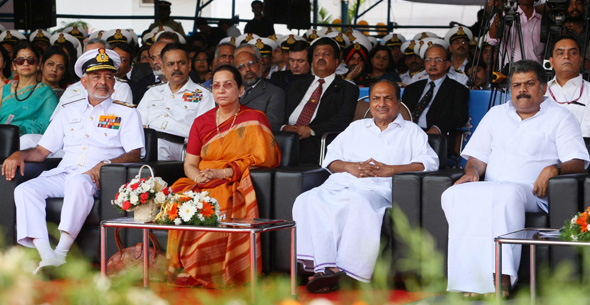
The Defence Minister, A.K. Antony, Smt. Elizabeth Antony, the Union Minister for Shipping, G.K. Vasan
and the Chief of Naval Staff, Admiral D.K. Joshi, at the launch of the India’s First Indigenous
Aircraft Carrier (IAC)
